Duke Farms Eagle Cam
Welcome to the Eagle Cam, a collaboration with Duke Farms, to help raise awareness for nesting bald eagles in New Jersey.
Bald Eagles are extremely sensitive to human disturbance. At no time should anyone approach nesting eagles. People who want to observe or photograph eagles and who come too close may actually cause the birds to abandon a nest.
Located on Duke Farms in central New Jersey, the Eagle Cam allows viewers an up close and personal view into the lives of a pair of bald eagles as they breed, incubate, and raise young. It is a perfect tool for teaching about wildlife and covers a variety of topics including animal behavior, bird biology and natural history, endangered species, food webs, contamination, and MORE!
2024 Nesting Season
1st egg laid January 22nd-hatched February 29th.
2nd egg laid January 25th-hatched March 1st.
April 16th, 2024
The banding team visited the Duke Farms nest yesterday April 15th in the morning. John Heilferty climbed to the nest and secured the chicks talons with vet wrap and a hood on over their head to keep them calm. They are then lowered to the ground in a bag. Measurements and blood samples are taken. The measurements tell us that both chicks are male. Each chick was banded with a green NJ band and a silver federal band. The chicks were then put back in the nest. An adult returned to the nest in the evening and all is well, both chicks are active and moving about the nest. Below is the banding information and photos.
H/45- male, oldest, largest chick
H/45(right leg) green band 0709-06581 (left leg) silver band
Culmen length (mm) 42.4
Bill depth (mm) 29.4
wing 8th primary (mm)- 185
Tarsus (fron to back (mm) 16.5
Tarsus side to side (mm) 13.0
Hallux Claw (mm) 33.7
weight (kg) 3.17
H/44 male, younger, smaller chick
H/44(left leg) green band 0709-06580 (right leg) silver band
Culmen length (mm) 40.3
Bill depth (mm) 27.9
wing 8th primary (mm)- 145
Tarsus (fron to back (mm) 16.7
Tarsus side to side (mm) 12.5
Hallux Claw (mm) 30.8
weight (kg) 2.76
 Zoom+ John Heiferty climbing nest tree @ Diane Cook
Zoom+ John Heiferty climbing nest tree @ Diane Cook Zoom+ Banding supplies@ Diane Cook
Zoom+ Banding supplies@ Diane Cook
 Zoom+ H44 hooded @Diane Cook
Zoom+ H44 hooded @Diane Cook Zoom+ H44 @ Diane Cook
Zoom+ H44 @ Diane Cook
 Zoom+ measuring the 8th primary feather @Diane Cook
Zoom+ measuring the 8th primary feather @Diane Cook Zoom+ H45 talons @ Diane Cook
Zoom+ H45 talons @ Diane Cook
 Zoom+ H45 hooded @ Diane Cook
Zoom+ H45 hooded @ Diane Cook Zoom+ H45 bands @Diane Cook
Zoom+ H45 bands @Diane Cook
 Zoom+ nest visit April 15th, 2024; band H45; photo by Diane Cook
Zoom+ nest visit April 15th, 2024; band H45; photo by Diane Cook
April 3rd, 2024
The chicks will be five weeks old the end of this week. They are growing fast and their pin feathers have started to appear. In the screen shot below you can see pin feathers on the end of tail, wings and back. The chicks have both been getting fed plenty of food. Over the past few days of rainy, windy weather the chicks have huddled under the adult for protection and when an adults not around they cuddle with each other.
Banding
The nest will be visited on Friday April 12th at 10am by State Biologists and Duke Farms staff. At that time the chicks will be taken out of the nest for measurements, blood work and banding. The banding date is weather- dependent.
 April 3rd, 2024
April 3rd, 2024 April 3, 2024; Chicks under adult
April 3, 2024; Chicks under adult
March 26th, 2024
All is well at the nest. A fish was brought in this morning and the smaller chick was fed plenty of food. We received many messages over the past few days about the lack of food in the nest and aggression of the 1st chick towards the 2nd chick. We understand and appreciate everyone's concern but please remember that this is nature and sometimes the reality can be harsh. While no intervention was needed in this situation, attempting one could cause more harm than good. Neither of the adults were missing over the past few days. There are several factors that could have contributed to the lack of food delivery. The heavy rain over the weekend caused flooding in the area and made hunting conditions difficult, hence the lack of food and aggression by the larger chick. There was also behavior from the adults that suggests there was an intruder eagle in the nest area and the adults were defending the nest from this eagle.
A close up of the chicks this morning show that the smallest chick doesn't have any damage to it's skin, from the larger chicks aggression. This morning a fish was brought to the nest by the female and the second chick was fed plenty of food. Hopefully today the nest gets stocked with more fish.
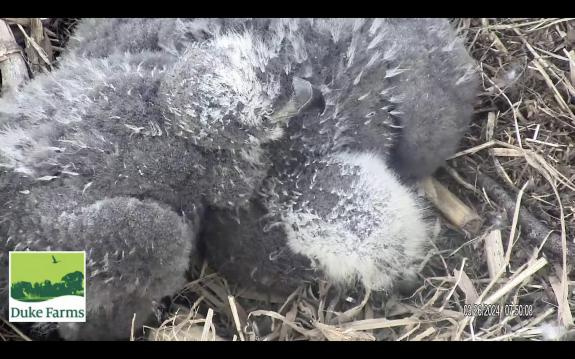 March 26th, 2024
March 26th, 2024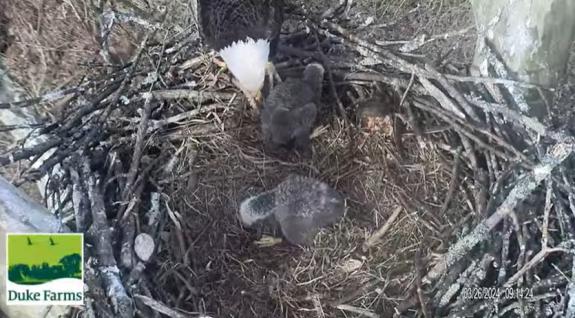 March 26, 2024, feeding
March 26, 2024, feeding
March 22nd, 2024
The cam gave some great close up views of the chicks. They have their second coat of thermal down and can thermoregulate themselves. They are now sitting up and walking around the nest. In the first 35 to 40 days of life eagle chicks grow rapidly, gaining weight and building bones, muscles, tissue.
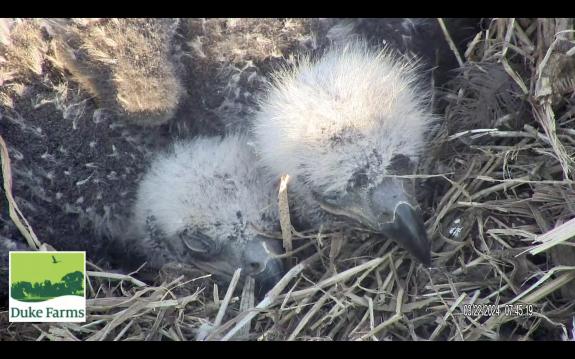 March 22nd, 2024
March 22nd, 2024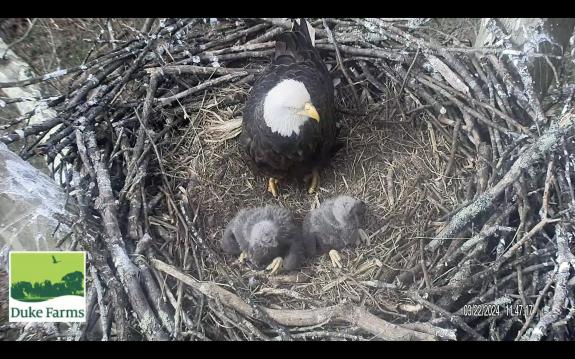 March 22nd, 2024
March 22nd, 2024
March 17th, 2024
The chicks are a little over two weeks old. Their down is now a medium gray on their bodies while their heads still have white down. They are getting more active and there is plenty of food being brought to the nest. Nest monitor Diane Cook noticed some unusual behavior by the chicks. The male came into the nest and settled down next to the chicks. Both chicks went after the male, he put them in their place but they went after him again. There wasn't food involved. The male doesn't spend as much time caring for the chicks perhaps they aren't use to him being in the nest?
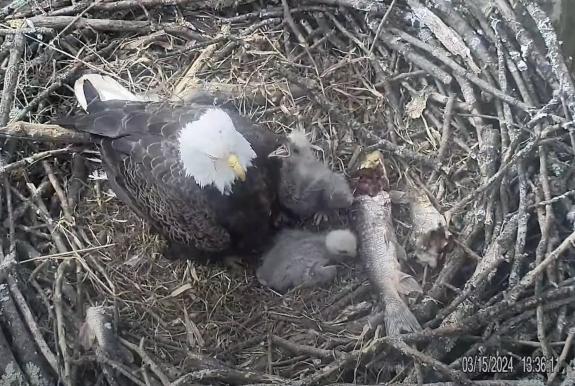 March 15th, 2024: chick 1, "yelling" at male
March 15th, 2024: chick 1, "yelling" at male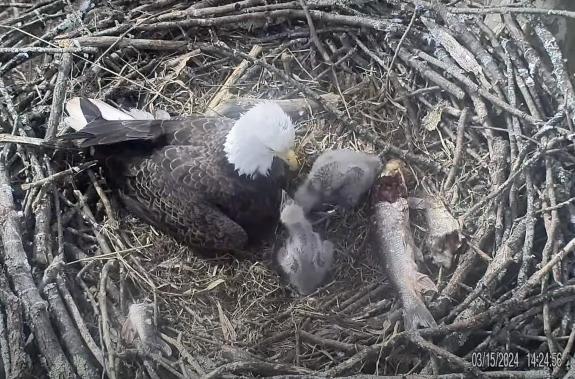 March 15th, 2024: chick 2 "yellling" at Dad
March 15th, 2024: chick 2 "yellling" at Dad
March 2, 2024
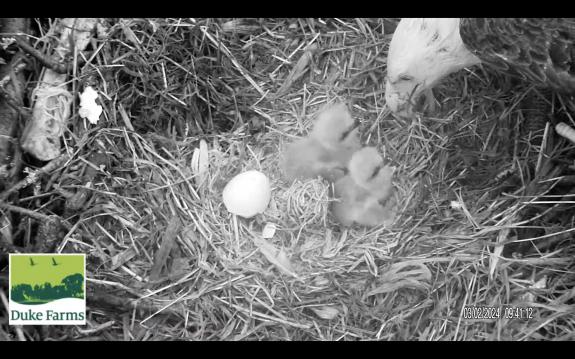 March 2nd, 2024, feeding
March 2nd, 2024, feeding March 2nd, 2024, egg tooth
March 2nd, 2024, egg tooth
March 1st, 2024
The first egg hatched yesterday afternoon. Around 1pm the 1st egg was hatching and the second egg had a small pip. The second egg hatched today at 7:23 pm.
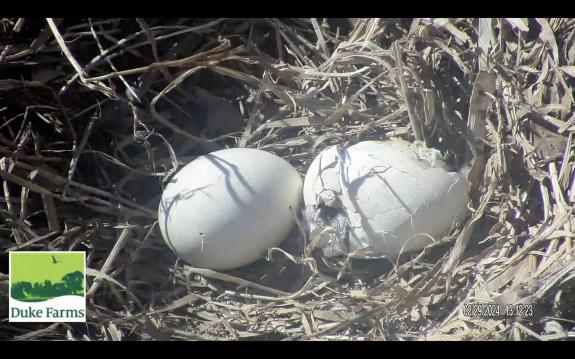 February 29th, 2024, egg hatching and pip.
February 29th, 2024, egg hatching and pip.
By 5:30 pm the chick had hatched out of the egg but the egg shell was still wrapped around part of the body.
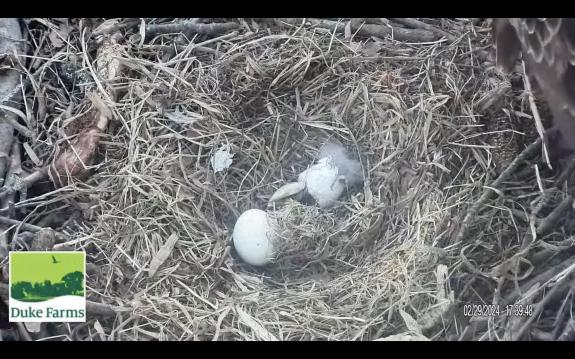 February 29th, 2024;
February 29th, 2024;
This morning we got a good look at the little ball of fluff.
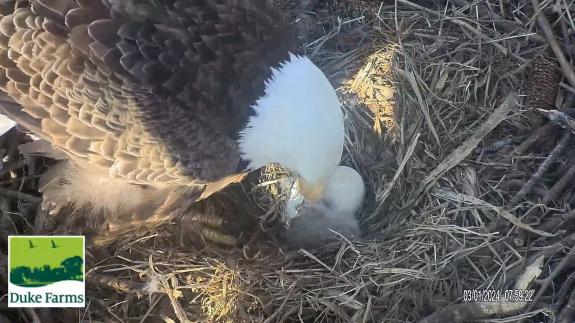 March 1st, 2024, good look at chick in morning.
March 1st, 2024, good look at chick in morning.
The adult is keeping both the hatching egg and chick warm on this brisk day. At around 2:30pm today we got a good look at the chick. It was bobbing its head and looking around. The adult attempted a feeding. It appeared to get a little food.
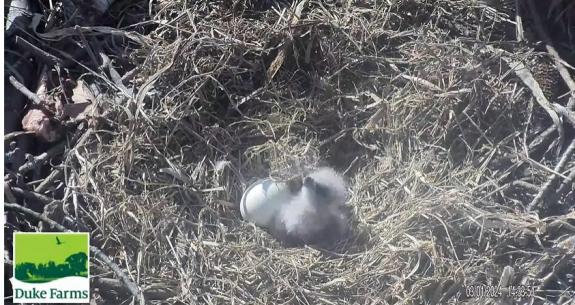 March 1st, 2024; chick waiting to be fed.
March 1st, 2024; chick waiting to be fed.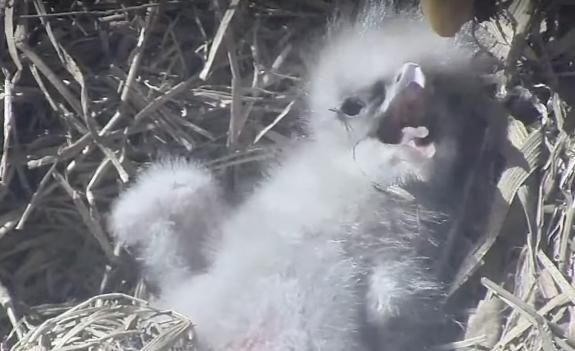 March 1st, thanks to Diane Cook for this adorable screen grab of the chick being fed.
March 1st, thanks to Diane Cook for this adorable screen grab of the chick being fed.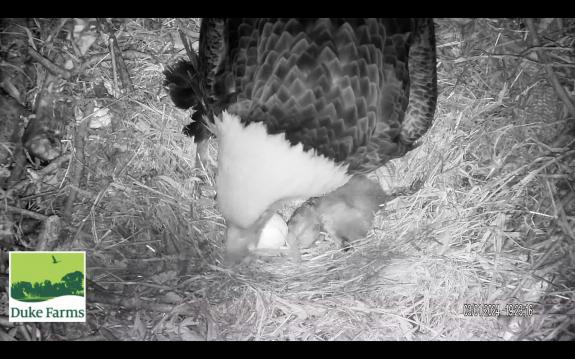 March 1st, 2024:7:23pm; 2nd chick hatched;
March 1st, 2024:7:23pm; 2nd chick hatched;
February 26th, 2024
Yesterday the male brought food to the nest, this is a good sign that hatching isn't too far off. Nest monitor Diane Cook reports that the female has been fluffing the nest bowl and rolling the eggs. Something landed out of view of the cam which caused her to put her wings out in a defensive posture. Today there wasn't a pip seen on the egg but both adults took turns incubating and rolling the eggs.
Journey North has an very informational document on Bald Eagle hatching.
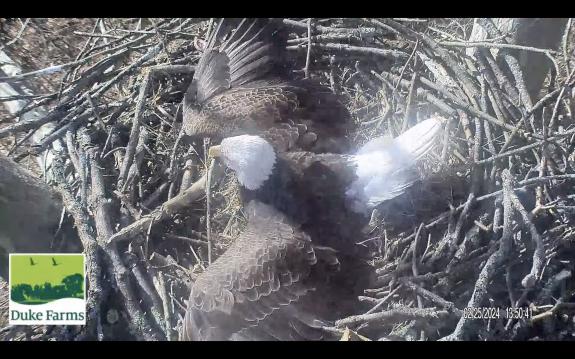 February 25th, 2024, female in defense posture
February 25th, 2024, female in defense posture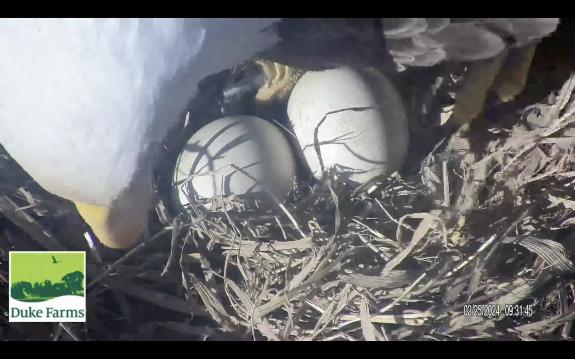 February 25th, 2024
February 25th, 2024
February 18th, 2024
The pair has been through two snow storms in just a week. On February 13th, the female incubated through the first storm. By the 15th the nest was mostly cleared of snow. Then another storm hit on the 17th and once again the female incubated through the storm, getting covered in snow. By the time the snow was finished she was surrounded by a wall of snow. Eagles develop a brood patch on their breast area before egg laying. The hormonal changes cause the feathering in this area to fall out leaving a patch of bare skin. Blood vessels in this exposed area bring warm blood close to the surface of the skin. The brood patch helps eagles incubate eggs even in the coldestweather.
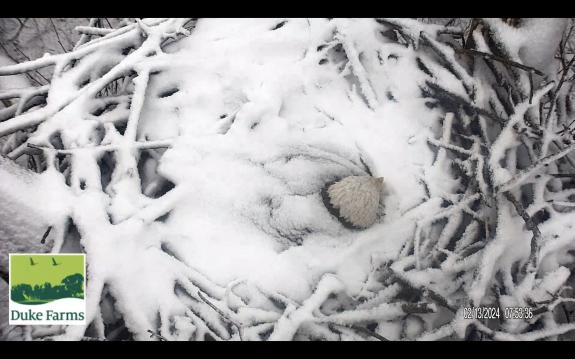 February 13th, 2024 snow storm
February 13th, 2024 snow storm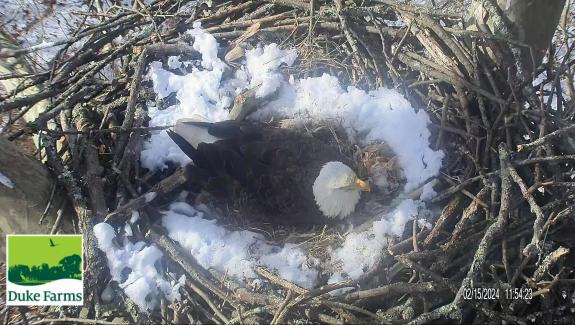 February 15th, 2024
February 15th, 2024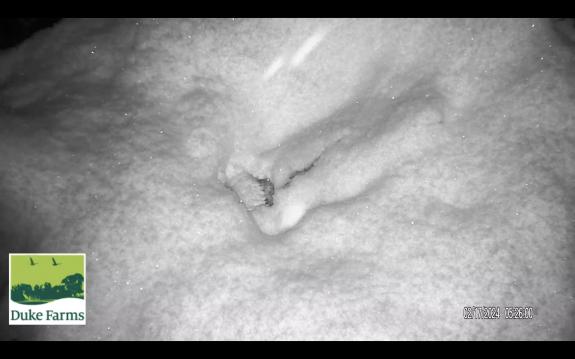 February 17th, 2014
February 17th, 2014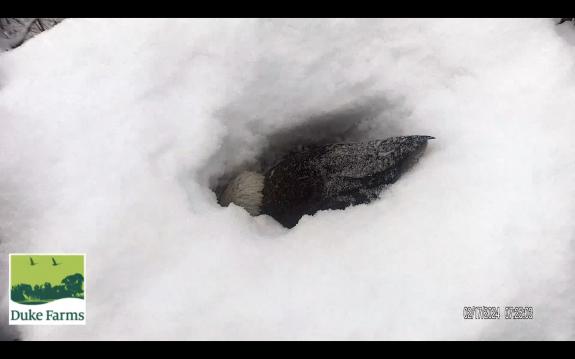 February 17th, 2024
February 17th, 2024
February 3rd, 2024
The pair has a two egg clutch this season. Since the male is new this season and not banded it is difficult to tell the male and female apart. The male does seem inexperienced. He was seen stepping on an egg, where as the female balls up her talons and gently walks around the eggs. The female is doing the majority of the incubation duties. The first egg was laid January 22nd so thirty-five days would be February 26th. But there is often delayed incubation on the first egg, so hatching will most likely occur after the 26th.
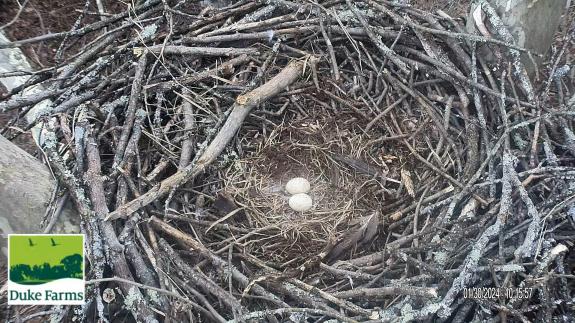 2 egg clutch, January 30th, 2024
2 egg clutch, January 30th, 2024
January 25th, 2024
The second egg was laid today around 3:36pm
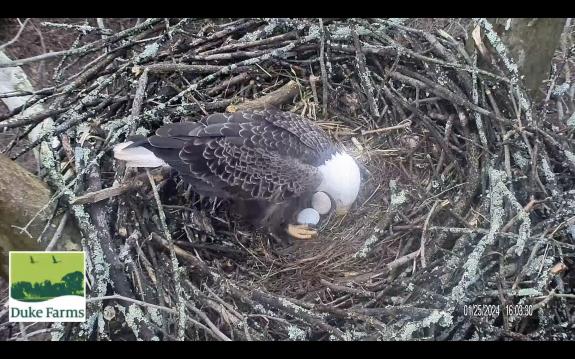 2nd egg laid, January 25, 2024
2nd egg laid, January 25, 2024
January 23nd, 2024
The first egg was laid yesterday. In the morning an immature eagle spent an hour in the nest. The cam got a nice close up of the immature eagles plumage.
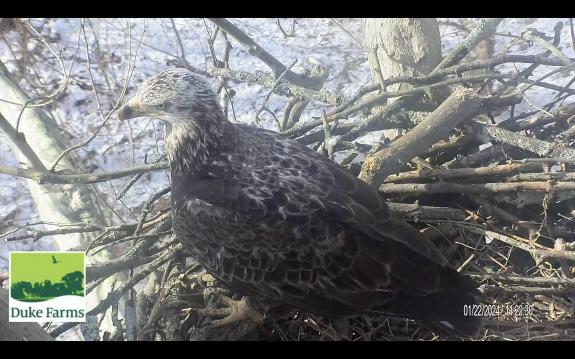 immature eagle January 22, 2024
immature eagle January 22, 2024
Nest monitor Diane Cook reports, "they finally returned to the nest after the visitor left - just before 3:30. They both poked around the nest a bit. She laid down while he brought back a new stick and began arranging. He even stepped on her once as her "labor" began! She spread her wings about 3:35, and the action picked up from there. He came back one more time to rearrange sticks. He finally left, and she could get down to business. It looks like the egg had arrived by 3:39. She stood up, looked under her, and then finally moved to show us the egg. She then gave it a little roll to the center of the cup."
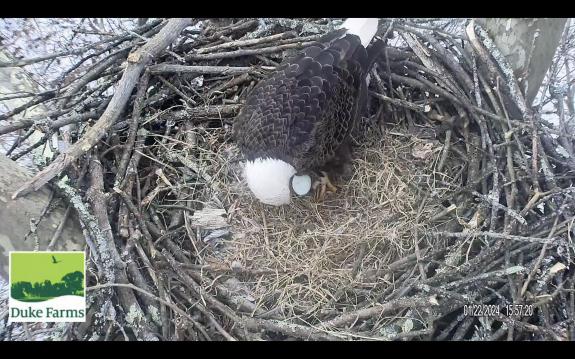 1st egg, January 22nd, 2024
1st egg, January 22nd, 2024
January 15th, 2024
Nest Monitor Diane Cook reports that today was a busy day at the nest: "The turkeys were back again this morning. One landed on a lower branch of the nest tree. I continued watching more begin running around the ground. At one time I counted at least 14, but there could have been more." The female brought a fish back to the nest later. She was not sharing with the male. There was an immature eagle who visited about 12:35. It landed on the branch, then went to the nest. It stayed about 20 minutes. Both eagles were back in the nest, adding and placing a new branch. She sat in the nest for some time this afternoon. About 3:15 the male brought in prey. It was hard to see, but it looked like the wing of a bird. She made it clear she would not share and he left soon after. "
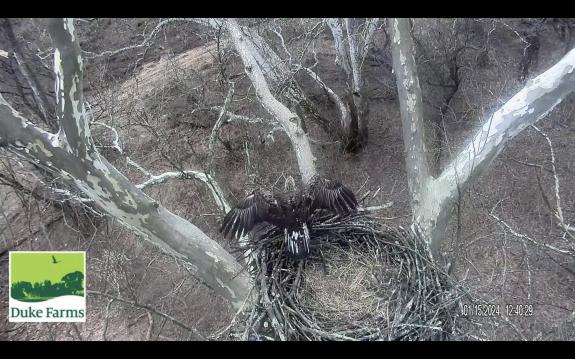 January 15th 2024
January 15th 2024
January 5th, 2024
The nest is looking good. The pair are often seen at the nest in the early morning hours and sometimes in the afternoon. In 2023 the first egg was laid on January 20th.
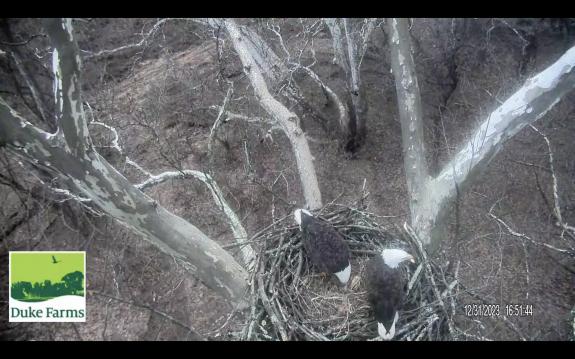 December 31st, 2023
December 31st, 2023
You never know what you'll see at the nest. Diane Cook got this screen shot of a turkey perched at the nest.
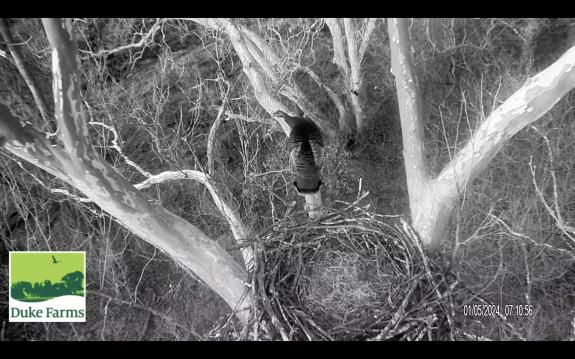 Turkey perched at nest, January 4th 2024
Turkey perched at nest, January 4th 2024
There is a new male in the pair. Sometime in the fall, a new male made his appearance, we know this because he isn’t banded. The previous male was NJ banded A/59, he was 23 years old. We don’t know what happened to A/59; he could have died or been injured and the new male took his place.
To the relief of cam viewers the newly formed pair started rebuilding the nest in October and have since been working together to prepare the nest for eggs. The pair has also been seen mating.
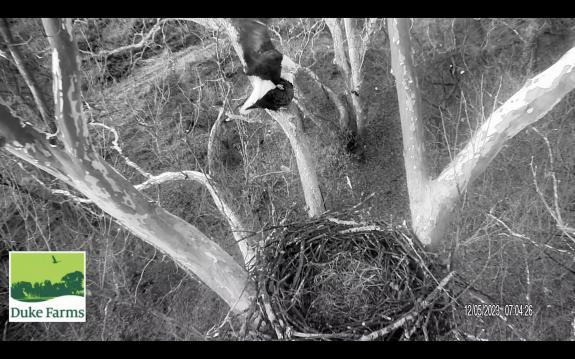 December 5th, 2023; pair mating
December 5th, 2023; pair mating
DUKE FARMS EAGLE CAM FAQS
How long have eagles been nesting at Duke Farms?
The eagle nest at Duke Farms was first discovered in the fall of 2004. The pair started using the nest in 2005. In the fall of 2012 Hurricane Sandy's 70+ mph tore off the upper half of the nest tree, destroying the nest completely (the camera and camera tree were spared). The pair built a new nest 100ft south of the eagle camera in late December 2012. The view of the nest was limited by branches and leaves during the 2013 nesting season.
In what type of tree is the nest located?
In December 2012 the pair built a new nest in a sycamore tree.
How high is the nest?
The nest is about 80 feet high.
How long has the camera been at the nest?
 Zoom+ Duke Farms eagle nest camera.
Zoom+ Duke Farms eagle nest camera.
The camera was set up in 2008 and transmitted the picture beginning in March 2008. In the fall of 2013 the camera was moved to the new nest tree.
Where is the camera located?
The camera is in the nest tree positioned above to view the nest from above. The camera can be maneuvered remotely to pan, tilt and zoom.
How many young have been raised in this nest?
A total of 32 eagle chicks have been raised and fledged from this nest since 2005.
- 2005 - 1
- 2006 - 2
- 2007 - 1
- 2008 - 2
- 2009 - 3
- 2010 - 2
- 2011 - 2
- 2012 - 1
- 2013 - 2
- 2014 - 3
- 2015 - 2
- 2016 - 2
- 2017 - didn't incubate
- 2018 - failed, 2 eggs
- 2019 - 2
- 2020 - 2
- 2021 - 2
- 2022 - 1
- 2023 - 2
When do the birds start incubating?
Over the past couple years the pair has typically began incubation in mid-late January. In 2021 and 2022, the pair started incubating on January 17 and in 2020 and 2023 they began incubation on January 20, 2023.
Are the adult eagles banded?
In 2009 and 2010 it was noted that both the male and female were NJ- banded birds, because they each had a green color band on one leg and a silver federal band on the other.
In 2011, however, there was a new female in the pair, which we know because she was not banded.
In 2020 there was a new unbanded female in the pair. In addition to behavior changes, close up views of the eyes showed a difference between the old and new female's iris.
Have any of the chicks been banded?
Yes, the chicks were banded in 2007, 2009, 2010, 2011, 2014,2016 & 2019 & 2022
- 2007 - 1 male
- 2009 - 3 males
- 2010 - 2 females
- 2011 - 2 males
- 2014 - 2 males, 1 female
- 2016 - 2 females
- 2019 - 1 male, 1 female
- 2022 - 1 male
- 2023 - not banded
How is the eagle cam funded?
Duke Farms hosts the eagle camera and the internet connection. The Endangered and Nongame Species Program and the Conserve Wildlife Foundation of NJ support their work and conduct the on-site banding and provide biological consulting.
How many eagle nests are in NJ?
In 2022 there were 267 nesting eagle pairs monitored in New Jersey. Two hundred fifty of these were active (laid eggs) and 197 were successful in producing 335 young.
Learn More:
Duke Farm Eagle Cam Update Archives:
Duke Farms 2022-2023 Eagle Cam Updates
Duke Farms 2021-2022 Eagle Cam Updates
Duke Farms 2020 Eagle Cam Updates
2019 Duke Farm Eagle Cam Updates - 1.7MB |
2018 Duke Farms Eagle Cam Updates - 11KB |
2017 Duke Farms Eagle Cam Nest Updates - 203.4KB |
2015 Eagle Cam Nest Updates - 701.0KB |
2014 Eagle Cam Nest Updates - 210.8KB |
2013 EagleCam Nest Updates - 19.8KB |
2011 EagleCam Nest Updates - 59.8KB |
2010 Eagle Cam Nest Updates - 31.0KB |
Find Related Info: Bald Eagles, Raptors








